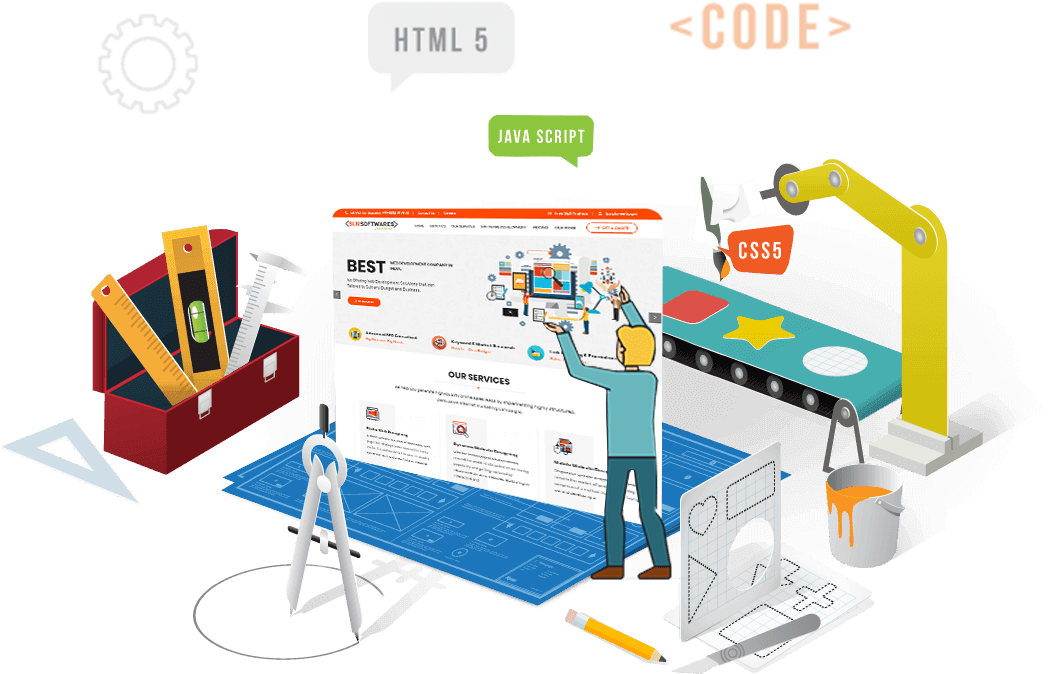Website Development
The process of website development starts with understanding the goals, target audience, and content for the website. This is followed by the design phase, where a visual design for the website is created, including the layout, color scheme, and overall aesthetic. The development phase involves writing the code for the website using programming languages such as HTML, CSS, JavaScript, and PHP. The backend functionality is also developed during this phase. Testing is done to ensure the website is free of errors and that it functions correctly on different devices and browsers. After testing, the website is deployed to a web server, making it accessible to the public. Regular maintenance is needed to ensure that the website continues to function properly, updates the content and security patches if needed.


Why website development is important for businesses?
Website development is important for businesses for a number of reasons:
Online Presence: Having a website allows a business to establish an online presence, making it accessible to customers 24/7, from anywhere in the world. This can increase brand awareness and make it easier for customers to find and learn about a business.
Reach a wider audience: A website allows businesses to reach a much wider audience than traditional brick-and-mortar stores. It can also be used to target specific demographics and geographic regions.
Cost-effective: A website can be a cost-effective way for a business to promote its products and services. It can also be used to automate certain business processes, such as taking orders, making it more efficient.
Increased Sales: A well-designed website can increase sales by making it easy for customers to find products and services, and by providing a user-friendly online shopping experience.
Marketing and Advertising: A website can be used as a powerful marketing and advertising tool. It can be used to promote products and services, increase brand awareness, and drive traffic to the site.
Customer Service: A website can be used to provide customers with information about products and services, and can also be used to handle customer queries and complaints.
Competitive Edge: Having a professional website can give a business a competitive edge over its rivals, helping it to stand out in a crowded market.
Overall, Website development is essential for businesses of all sizes to establish a digital footprint, reach a wider audience, and stay competitive in today's digital economy.
The process of website development typically involves the following steps:
Planning: This step involves identifying the goals, target audience, and content for the website. A plan is created to outline the overall structure and layout of the website.
Design: This step involves creating a visual design for the website, including the layout, color scheme, and overall aesthetic. A wireframe or mockup is created to provide a visual representation of the website's design.
Development: This step involves writing the code for the website using programming languages such as HTML, CSS, JavaScript, and PHP. The backend functionality is also developed during this step.
Testing: This step involves testing the website to ensure it is free of errors and that it functions correctly on different devices and browsers.
Deployment: This step involves publishing the website to a web server, making it accessible to the public.
Maintenance: Once the website is live, regular maintenance is necessary to ensure it continues to function properly, update the content and security patches if needed.
Note that this process may vary depending on the specific requirements and complexity of the website, and may also include additional steps such as search engine optimization (SEO) and analytics implementation.
Planning: This step involves identifying the goals, target audience, and content for the website. A plan is created to outline the overall structure and layout of the website.
Design: This step involves creating a visual design for the website, including the layout, color scheme, and overall aesthetic. A wireframe or mockup is created to provide a visual representation of the website's design.
Development: This step involves writing the code for the website using programming languages such as HTML, CSS, JavaScript, and PHP. The backend functionality is also developed during this step.
Testing: This step involves testing the website to ensure it is free of errors and that it functions correctly on different devices and browsers.
Deployment: This step involves publishing the website to a web server, making it accessible to the public.
Maintenance: Once the website is live, regular maintenance is necessary to ensure it continues to function properly, update the content and security patches if needed.


There are several types of website development, including:
Static website development: A static website is a simple website that has fixed pages and content. The content on these pages does not change unless manually updated by the developer.
Dynamic website development: A dynamic website is more interactive and allows for the content to change or be updated automatically. This type of website typically uses a database to store and retrieve information.
E-commerce website development: An e-commerce website allows for the buying and selling of products or services online. It typically includes features such as a shopping cart, payment gateway integration, and inventory management.
Content management system (CMS) website development: A CMS website allows the owner of the website to manage and update the content on their own, without the need for technical knowledge.
Responsive website development: A responsive website is optimized to adapt to different screen sizes and devices, ensuring that the website looks good and is easy to navigate on all devices, including smartphones and tablets.
Single-page website development: Single-page websites are a specific type of website that only have one page and it loads all the content at once, by scrolling or clicking on the navigation.
Progressive web apps (PWA): PWAs are web apps that look and feel like native mobile apps and can be accessed through a web browser.
Hybrid mobile app development: A hybrid mobile app is a website that is wrapped in a native app. It allows the app to be accessed from any device through a web browser, but with the look and feel of a native app.
The type of website development will depend on the specific needs of your business, your budget and the target audience.
Static website development: A static website is a simple website that has fixed pages and content. The content on these pages does not change unless manually updated by the developer.
Dynamic website development: A dynamic website is more interactive and allows for the content to change or be updated automatically. This type of website typically uses a database to store and retrieve information.
E-commerce website development: An e-commerce website allows for the buying and selling of products or services online. It typically includes features such as a shopping cart, payment gateway integration, and inventory management.
Content management system (CMS) website development: A CMS website allows the owner of the website to manage and update the content on their own, without the need for technical knowledge.
Responsive website development: A responsive website is optimized to adapt to different screen sizes and devices, ensuring that the website looks good and is easy to navigate on all devices, including smartphones and tablets.
Single-page website development: Single-page websites are a specific type of website that only have one page and it loads all the content at once, by scrolling or clicking on the navigation.
Progressive web apps (PWA): PWAs are web apps that look and feel like native mobile apps and can be accessed through a web browser.
Hybrid mobile app development: A hybrid mobile app is a website that is wrapped in a native app. It allows the app to be accessed from any device through a web browser, but with the look and feel of a native app.